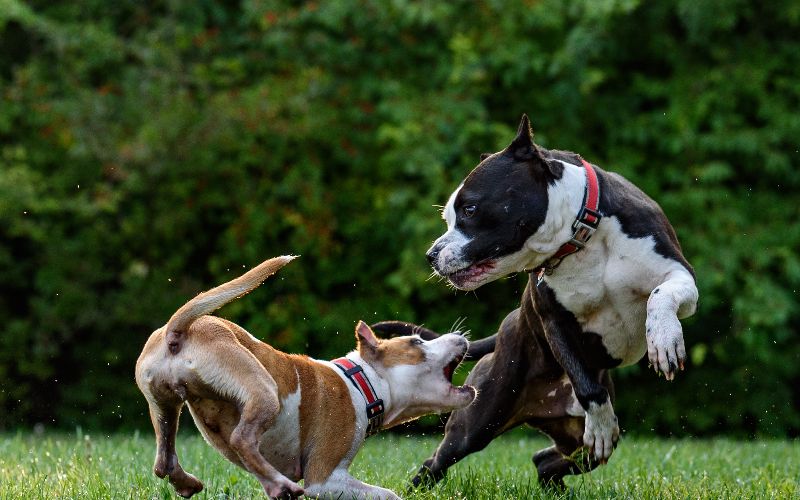Have you noticed occasional outbursts of unpredictable and uncontrollable aggression in your otherwise calm dog lately? If yes, then searching it up was the right thing to do— this behavior is not normal!
In fact, there are high chance that your precious might be suffering from a rare disease called rage syndrome. But don’t panic! Yes, disease is a heavy word, but rage syndrome is neither fatal nor incurable. We get a call about this every once in awhile at miamiolk9.com
In this blog, we will briefly discuss everything you need to know about rage syndrome in dogs, alongside how you can manage and treat it. Let’s begin!
What is Rage Syndrome?
To understand what rage syndrome is, you must understand this: It is NOT behavioral aggression or reactivity. Instead, it is intense, unprovoked aggression outbursts in an otherwise pleasant dog.
It is especially frequent in English Springer Spaniels and Cocker Spaniels. This is why rage syndrome is also referred to as Cocker rage or Springer rage. It is also common in German Shepherds, Doberman Pinschers, Bernese Mountain Dogs, Lhasa Apsos, Bull Terriers, Retriever breeds, and St. Bernards.
Causes
Since there is no trigger for these episodes, rage syndrome is classified as a case of idiopathic aggression. This is why there is no proven “cause” for this disease. However, according to general consensus, the common causes are:
- genetics,
- brain tumor,
- stroke,
- trauma,
- partial complex seizures,
- extreme dominance aggression.
Note that dominance aggression, or status aggression, starts showing in most dogs when they are 1-3 years old. But, since it is also a common age for idiopathic epilepsy to develop, you may need to stay on the lookout for possible symptoms of rage syndrome.
Symptoms and Management
Diagnosing rage syndrome in dogs can get tricky, and vet consultation is essential. But before that, you can check for the following symptoms that may occur before, during, or after an aggressive episode:
Attacks Without Provocation
One minute you are cuddling your dog and petting its soft fur, the next minute it starts barking at you— aggression without any apparent reason. You might even receive a muzzle punch!
Attacks Without Warning
Most dogs stare or growl before attacking. But, a dog suffering from rage syndrome may attack without any warning. These attacks may include repeated biting, hard-nipping, baring teeth, and curling lips.
Dog’s Body Becomes Stiff
If the pupils dilate to the point that the dog looks possessed, and its body stiffens during an aggression episode, it is a symptom.
Shows No Feeling of Reconciliation
A dog suffering from rage syndrome does not show any sign of remorse. It is confused, tired, and feels agitated most of the time.
Dogs may also go through depressive episodes before or after their aggression episodes. If you notice any of these symptoms in your dog, seek professional help to get a proper diagnosis immediately. Remember: behavioral changes are also a symptom.
Tips to Control Your Dog’s Rage
Other than diagnosis, medication, and therapy, there are some steps that you must take to help control your doggo’s rage and help them feel better. We suggest,
1. Giving Your Dog a Safe Space
Making a separate comfortable space for the dog helps ease a dog if he gets overwhelmed. Make sure the place is accessible to your dog and is free from any potential triggers.
2. Aiming For Positive Reinforcement
Have you heard of the phrase “love conquers all”? Well, that helps! Focus on building a sentimental relationship with your dog with a positive attitude. Avoid using harsh or intimidating techniques to handle your dog unless necessary.
3. Implementing a Consistent Routine
A daily routine with a fixed schedule can help your dog with its rage syndrome. Allocate times for playing, eating, going out, and resting. Then, stick to the routine consistently. It will keep your dog busy throughout the day and eventually make him healthier.
4. Educating Family Members and Friends
You can only help a dog with rage syndrome through effective management. So, everyone in regular contact with your dog must understand the condition properly. Educate yourself, your family, and your friends on how they can tell if an aggression episode is about to begin and what they should do in such a situation.
5. Monitoring and Manage Behavior
Try to understand your dog’s condition and manage it as effectively as possible. Monitor the behavior constantly so you can understand when a change is required.
If the situation gets out of control, go for medication! Anti-anxiety medications and anti-seizure medicines like phenobarbital can be especially useful in helping manage extreme emotions in dogs with rage syndrome. We also recommended training to work on improving your dog’s behavior with therapy.
Unfortunately, if your dog’s aggression levels reach the maximum point, the only solution left for everyone’s betterment is the one we all hate the most: euthanizing your dog.
Wrapping Up
Rage syndrome can be a lifelong condition, and requires a lot of patience at the owner’s end.
So, if you’re dog shows any signs of uncalled-for aggression that obviously does not look normal, it’s time to go to the vet. Getting a diagnosis is the first step to helping your dog if they’re suffering from rage syndrome. If the vet suggests, start medication.
The second step is managing the aggression episodes and your pal’s behavior at home. Remember, be more attentive, considerate, consistent, and alert. Set a proper routine, give your dog a safe and healthy environment, and aim for positive reinforcement.
The last step is to start training. Since the causes of rage syndrome are still not proven, there is no proper medical treatment for this disease. However, therapy and training can, in most cases, help effectively manage the condition and decrease aggression levels significantly.


